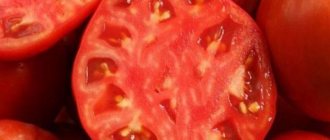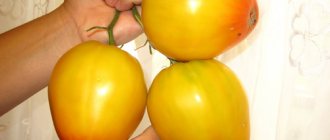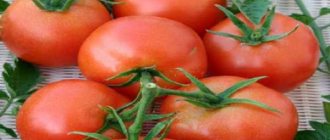Main characteristics of BIF tomato Nina and description of the variety
Tomato Nina belongs to the semi-determinate type
and in most of Russia it is grown only in greenhouse conditions. And only in the south of the country can it be planted in open ground. The Nina tomato is an early ripening variety - no more than 3.5 months can pass from the moment of germination of the seed material to the harvesting of ripe fruits.
Photo of tomato Nina
The bushes are tall, erect, strong, strong shoots can reach 1.7-1.75 m in height. The stems are well leafy, without pubescence. The foliage is typical for tomatoes, narrow, elongated, slightly wrinkled, dark emerald in color.
The Nina variety requires the mandatory formation of bushes
- it is better to leave no more than 2 shoots on each bush. It is also necessary to regularly remove the shoots and tie the bushes to strong supports so that the stems do not break under the weight of ripening fruits.
The first inflorescence appears above the 8-9 leaf, and each subsequent one appears after three true leaves. Small flowers are collected in racemes of complex or semi-complex shape.
Huge ribbed tomatoes. Variety Nina - video
The main advantage of the Nina variety is its large fruits with an unusual ribbed shape.
Cut fruits look beautiful on plates and also in salads. The shape of the fruit is flat-round with clearly defined ribbing. The color of ripe tomatoes is deep red, while the tender, fairly dense and juicy flesh has a crimson color.
Inside the fruit there are several seed chambers with a small number of seeds. The skin of the fruit is of medium thickness, with a slight shine. Tomatoes are not prone to cracking, tolerate transportation well over different distances, and can be stored for quite a long time in appropriate conditions. During transportation and storage, the harvested crop does not lose its original presentation and taste.
Photo inside the Nina tomato fruit
On a note!
The large-fruited nature of the Nina tomato is another advantage of this variety. The weight of the fruit can be 350-400 g, but the first tomatoes can weigh even more - up to 650-700 g. The taste of ripe tomatoes is sweetish with a small amount of acid.
This salad variety looks great when sliced; there are voids in the pulp.
The Nina tomato calmly tolerates temperature fluctuations, while its growth and fruit ripening do not slow down.
Brief information about the variety
- Fruits and bush : red tomatoes, average weight - 350-400 g. The semi-determinate bush reaches 1.2-1.8 m in height.
- Productivity : up to 20 kg per 1 m².
- Resistance : strong immunity against fungal, viral and bacterial infections. Cold resistance.
- Distribution : the entire territory of Russia.
- Application : preparing salads, appetizers, burgers, lecho, sauces and juice. Tomatoes are suitable for canning, but not in their entirety. They are often used for cutting vegetables.
- Planting : seedling method; Tomatoes are transplanted into a greenhouse in mid-May, into open ground at the end of May or early June; diagram – 60×70 cm.
- Soil : light, loose, fertilized with organic and mineral fertilizers.
- Care : watering, loosening, fertilizing, shaping and tying.
- Ripening period : mid-early variety - the fruits ripen on the 100th day from the moment the first true leaves appear. Tomatoes can be stored for about 1.5 months.
Productivity of tomato variety Nina
This variety belongs to beef tomatoes, and the yield of such varieties is always high.
Fruiting of Nina tomatoes is extended over time - the first fruits ripen in the last ten days of June, and the harvest ends in the second or early third ten days of August.
Tomato Nina. Very tasty large-fruited tomato - video
When growing no more than 3 bushes on one square of area, 18-21 kg of ripe fruits are collected from 1 m2 over the entire summer period. If agricultural practices are followed, at least 5-5.5 kg of ripe tomatoes are harvested from each bush.
EXCELLENT VARIETIES OF TOMATOES!
Tomato Rocket Tomato Kiss Description of Bearpaw tomatoes
Features of cultivation
Sowing the seeds of this variety of tomatoes for seedlings is carried out 60-65 days before the intended planting in the ground. Seedlings dive at the stage of two true leaves. When planting seedlings in a permanent place per 1 sq. Up to 4 plants are placed per meter of the prepared area.
In some catalogs this variety is called Zlatovo.
This is a natural variety of tomato. Therefore, we recommend taking seeds from a ripe fruit and using them for planting in subsequent seasons.
If you grew Zlatava tomatoes, please write how you liked them. What was the yield and taste of the fruits in your climatic conditions? Will you grow them again? If possible, attach to your review a photo of the entire bush or individual fruits you grew. Thank you!
Your reviews of the Zlatava tomato and additions to the description will help many gardeners evaluate this variety more objectively and decide whether it is worth planting or not.
Diseases and pests
The originators of the variety say that this tomato has good immunity and is practically not affected by diseases characteristic of other tomato varieties.
Photo of bushes with tomatoes of the Nina variety
In particular, the Nina tomato does not suffer from blossom end rot, tobacco mosaic virus and Alternaria blight.
But still, for prevention purposes, the bushes should be treated with fungicidal preparations several times a season.
You should also periodically inspect the bushes for pests. If they are found, then appropriate insecticides must be used for treatment. Any treatments of tomato bushes should be stopped a couple of weeks before harvest, since these drugs are not immediately removed from the fruits and vegetative mass.
Babushkino tomatoes on video
Conduct intervarietal crossing of tomatoes
The variety is very productive; additional feeding is required.
This variety is not listed in the State Register of Breeding Achievements of the Russian Federation. Since this tomato is an amateur selection, you can purchase its seeds from collectors. Agricultural companies do not deal with this variety.
This is a natural variety of tomato. Therefore, we recommend taking seeds from a ripe fruit and using them for planting in subsequent seasons.
If you grew Babushkino tomatoes, please write whether you liked them or not. What was the yield and taste of the fruit under your conditions? How do you rate the disease resistance of this variety? If possible, attach a photo of the entire bush or individual fruits you grew to your comment. Thank you!
If you are interested in other varieties of tomatoes from collectors, we recommend that you look at the Catalog of tomato varieties with photos and descriptions from private producers.
Advantages and disadvantages
The main advantages of the Nina tomato variety include:
- high productivity and extended fruiting;
- large-fruited and original appearance of tomatoes;
- immunity to most diseases characteristic of tomatoes;
- the variety is able to tolerate low temperatures without harming the growth and development of fruits;
- The Nina tomato can be grown in greenhouses and film greenhouses, as well as in beds in the garden.
Interesting article:
Why the leaves of tomatoes in a greenhouse dry out and turn yellow.
The disadvantages should be noted:
- high growth of shoots, so low greenhouses and hotbeds are not suitable for growing them;
- the need to form and garter bushes, as well as regular pinching.
But experts note that this tomato has much more advantages than disadvantages.
Features of growing American ribbed tomatoes, planting and care
We recommend sowing seeds for seedlings 65-70 days before the intended planting in the ground. Picking - at the stage of 2 true leaves. When transplanting seedlings to a permanent place, 1 sq. m it is recommended to plant up to 3 plants, when forming into 1 trunk - up to 4. Planting pattern: 50 x 40 cm.
Further care for tomatoes consists of timely watering, weed removal, fertilizing, pinching and preventive measures to protect the crop from diseases and pests.
The variety is resistant to major tomato diseases.
The yield is high - up to 5.5 kg of fruit from 1 bush (subject to the observance of agricultural technology, the presence of watering and fertilizing).
Formation of tall tomatoes in a greenhouse
If you grew American ribbed tomatoes, please write whether you liked them or not. What was the yield and taste of fruits in your climatic conditions? How do you rate the disease resistance of this tomato? Briefly describe the advantages and disadvantages of this tomato in your opinion. If possible, attach to your review a photo of the entire bush or individual fruits you grew. Thank you!
Your reviews of the American ribbed tomato and additions to the description will help many gardeners evaluate this variety more objectively and decide whether it is worth planting or not.
You can see other interesting varieties and hybrids of tomatoes with photos, descriptions and reviews in our Tomato Catalog. Enjoy watching. This is a natural variety of tomato. Therefore, we recommend taking seeds from a ripe fruit and using them for planting in subsequent seasons.
Growing tomato Nina: from seedlings to planting in open ground and greenhouse
To obtain high yields from this variety, it is necessary to provide it with special care, as well as to properly grow the seedlings.
It is optimal to plant Nina tomato seed material in the second ten days of March. Moreover, you can plant pre-soaked seeds, but you can also sow them dry - they still germinate at about the same time.
Photo of tomato seedlings Nina
But for better plant growth in the future, it is recommended to keep the seed material in a solution of special nutritional preparations before planting. You can also use ash solution for this - 4 tbsp. l. wood ash is diluted in 2 liters of hot water. This solution should be infused for a couple of days.
It is better to immediately plant the seed material in separate containers, so as not to further injure the plants during the diving procedure. Soil for planting can be purchased at gardening stores or prepared at home. To do this, river sand is mixed with humus, and there should be more sand. To make the soil looser, you can add chopped sphangnum moss to it.
Growing beef tomatoes in a greenhouse - video
After planting, the containers are covered with polyethylene and placed in a warm place for germination. Usually the first shoots appear after 6-8 days.
After this, the polyethylene is removed, and the containers with Nina tomato seedlings are placed in a well-lit place. In the first days, the temperature in the room must be lowered so that the seedlings harden. Then the containers are transferred to a warmer place with a temperature of at least 21-22 degrees Celsius.
THE BEST VARIETIES OF TOMATOES!
Tomato The Pride of Siberia Tomato Argonaut Tomato King of the Giants
If the seedlings have sprouted too thickly, then they should definitely be pruned. Water the plants first. Each plant is carefully removed from the soil, trying not to damage the roots. The central root is pinched to stimulate the growth of lateral roots. Then the plants are transplanted into another container, deepening them to the first leaves. The soil is compacted and the containers are moved to a shaded place.
Watering of pruned seedlings is carried out 2-3 times a week.
10-12 days before transplanting tomatoes to a permanent place, they begin to harden them, taking them out into the air for a short time. But gradually the period of stay of plants outside is increased.
Photo of transplanting tomato seedlings
Nina tomato seedlings are transplanted into open ground garden beds in mid-May.
Seedlings can be planted in the greenhouse earlier - in the last days of April.
The distance between neighboring tomatoes in rows is 0.5 m, and the row spacing is 0.4 m. 3-4 plants should be planted on each square of area.
Transplanting to a garden bed
Usually, Nina tomatoes are transplanted into a greenhouse in mid-May, and into open ground at the end of May or early June. 10 days before planting, tomatoes are accustomed to outdoor air conditions - they are taken out into the fresh air every day and kept there for 1-1.5 hours. Gradually, the time spent in the open air is increased, and on the last day the seedlings are left overnight under a film in the fresh air.
Preparing the site
When planted in the garden, tomatoes require a sunny place where there are no swamps and strong winds. The best predecessors are legumes, cucumbers, all varieties of cabbage, beets, onions and garlic.
The soil is suitable loamy or sandy loam, non-acidic. To increase fertility, it is sprinkled with humus (10 kg), wood ash (3 kg), superphosphate (100 g) and potassium salt (80 g). Additionally, for deoxidation, you can add 300 g of dolomite flour or chalk. This amount is calculated for a plot of 1 m².
():
This composition - chalk, dolomite flour, wood ash in large quantities (3 kg per 1 square meter) is used only on acidic soils. On neutral, and especially alkaline, chalk and dolomite flour are strictly prohibited, and the rate of ash application should not exceed 250 g per square meter.
All fertilizers are applied in the fall, then the soil is dug up, leveled and watered.
():
In the fall, when digging, the soil is not leveled, much less watered. The autumn rains will water the earth themselves. But if it is loosened, the dug up soil will become very compact over the winter and will have to be dug up again in the spring. In autumn, digging is carried out without breaking up the lumps.
In the spring, 2 weeks before planting tomatoes, the area is watered with a urea solution (600 g per 20 liters of water). This fertilizer saturates the soil with nitrogen and also destroys all pathogenic microflora in the area.
Planting scheme
Tomato bushes of the Nina variety are very tall, so the maximum number of plants per 1 m² is 4 pieces. Planting pattern – 60x70 cm.
They dig holes according to the size of the root system of the seedlings, water them with water, and after absorbing the moisture, lower the roots into the holes, sprinkle them with earth, compact them and hill them up.
Further care for the Nina tomato variety
Since this variety is demanding on soil moisture, it is recommended to provide drip irrigation in the beds with Nina tomato. In this case, the soil will not become waterlogged, and each plant will be provided with a sufficient amount of moisture.
INTERESTING!
Varieties of black tomatoes
After watering, the soil around the bushes is loosened, while removing weeds. To ensure that moisture evaporates more slowly, it is recommended to add a layer of mulch to the root zone of tomatoes. Straw or grass can be used as a mulching element.
Important!
It must be remembered that these tomatoes require mandatory shaping, removal of stepsons and tying to strong supports. It is necessary to carry out pinching once every 1-1.5 weeks.
How to feed tomatoes Nina
Tomatoes of this variety require regular feeding to form large fruits. Typically, mineral complex fertilizers are applied to tomatoes at least three times during the season. But you can also add organic matter – greenfinch or mullein – under Nina tomatoes.
All tomato fertilizing is done in liquid form immediately after watering.
Reviews from those who planted Nina tomatoes
Many gardeners have already tried to grow the Nina tomato, reviews of which are presented below.
Ivan, 40 years old, Rostov region: I first saw the seeds of this variety on the Internet a year ago and bought a couple of bags to try. I grew it in seedlings - I didn’t dare to sow the seeds directly into open ground. The seeds have all sprouted! The seedlings grew strong and healthy. There was no particular hassle with growing it. Transplanted to the beds in the garden in mid-May. After transplanting, I cared for the bushes of the Nina variety in the same way as other tomatoes. I just had to form the bushes into two stems (as it was written in the description of the variety). As a result, from each square I collected at least 18 kg of original, beautiful and large fruits.
Elena, 45 years old, Krasnodar region: Last season I decided to purchase seeds of a purely salad variety of tomato. I was recommended a new product - the Nina tomato variety. And “Nina” did not disappoint - the fruits ripened gradually, very large and tasty. As a result, throughout almost the entire summer I had fresh, delicious tomatoes on my table every day. I recommend planting this variety to everyone who loves salad varieties of tomatoes.
Olga, 35 years old, Novosibirsk: 2 years ago we bought a dacha, immediately installed a greenhouse and started growing tomatoes, cucumbers and peppers in it. I conduct experiments and buy many varieties of vegetables; this summer I grew Nina’s tomato, among others. A very worthy variety, with good taste characteristics. I recommend!
This tomato variety can be grown both in greenhouse conditions and in open ground, but manufacturers still recommend a greenhouse to obtain the best Nina tomato yields.
Thanks to its main advantages - good yield, large fruit, original appearance of the fruit - the Nina tomato already has its adherents among vegetable growers from different Russian regions. The seeds of this new product can be purchased on the seed market via the Internet from the agricultural company Partner, and they are also available for sale in specialized stores.
Reviews from gardeners
Almost all gardeners who grew the Nina tomato variety were satisfied with the result:
- with timely pinching, tying, feeding and watering, the bushes produce large, fleshy and tasty tomatoes;
- good productivity indicators are noted by gardeners in the risky farming zone - the tomatoes are not only beautiful, but also sweet and aromatic;
- Due to its excellent taste, yield and presentation, many gardeners prefer this particular crop.
Tomato Nina: description from the manufacturer Partner
The variety is mid-season, semi-determinate, and belongs to the beef tomato type. From germination to the first harvest it takes about 100 days. The first inflorescence is formed above the 9th leaf, the subsequent ones after 3. The racemes are semi-complex and complex. The fruits are flat-round in shape, with an extravagant appearance, pronounced high-relief ribbing; the resulting lobes are similar to each other and completely envelop the tomato from the stalk to the top.
Tomatoes have a deep red bright color. The flesh has an even richer color and appears crimson-red. The seed chambers are small, the central part of the pulp is large, so the tomato is fleshy, fully ripe on the bush, juicy, fragrant, very beautiful. The taste is excellent: sweet with a slight pleasant sourness and a real smell of tomatoes.
It is advisable to form the plant into 2 stems.
The variety is resistant to blossom end rot and tolerant to TMV and Alternaria blight. Planting density is about 4 plants/m2. Productivity over 20 kg/m2.
Care requirements
All further care of the garden bed is simple and comes down to a few standard activities.
In the first days, Nina tomatoes require protection from the sun during the day and from the cold at night. Therefore, they are covered with agrofibre during the day or with film at night.
Watering
The first moistening is carried out a week after transplanting the tomatoes into the garden bed. All subsequent waterings are necessary as the soil dries out. Watering is important at the stage of blooming flowers and filling fruits, which improves the quality of flowering and improves the taste of the fruits. Water is poured at the root to avoid rotting and burning of stems and foliage.
After watering, the soil is loosened and weeded between the rows. To protect against drying out, the stems are covered with garden soil after each loosening.
Feeding
Tomato responds positively to fertilizing with organic and mineral fertilizers. 3 weeks after transplanting the bushes, the plants are watered with a urea solution - 15 g are dissolved in a bucket of water. Consumption per bush – 200 ml.
Before flowering and during the filling phase of tomatoes, add mineral components (superphosphate and potassium - 15 g per bucket of water). 0.5 liters of working fluid is poured under each plant. Additionally, the bushes are irrigated with a solution of boric acid (0.2 g of powder is dissolved in 1 liter of warm water). Spray before and after flowering.
Formation
For this variety, the formation of a bush of 1-2 stems is suitable. In the first case, all stepsons and leaves developing under the flower brush are removed. When forming into 2 stems, the same manipulations are carried out, only one more stepson is additionally left above the flower brush.
Tomatoes need to be properly cared for
As they develop, tall tomato bushes need staking, which will protect the stems from breaking off under the weight of the fruit.
Temperature and humidity
Greenhouse tomatoes require stable heat (20-23 °C) and humidity at 45-60%. On sunny days, ventilation is carried out during the day.
Prevention of diseases and pests
Greenhouse tomatoes are susceptible to rot. To avoid this, it is necessary to prevent waterlogging of the soil, regularly loosen the soil and weed it between the rows. It is also important to follow the bush planting pattern.
To prevent damage to tomatoes planted in open ground and greenhouses by fungal, viral and bacterial infections, they are treated twice with the preparation “Skor”, “HOM” or a solution of copper sulfate. The first treatment is done 3 weeks after transplanting the seedlings to the garden bed, the second – before flowering.
To protect against pests - aphids, spider mites, whiteflies - the row spaces are sprinkled with ash and hot pepper powder. In case of parasites, the bushes are irrigated with an ash-soap solution or infusion of garlic and tobacco.
Among the chemicals that help control pests are “Aktellik”, “Aktara” and “Fufanon”. Treatment is carried out a month before the planned harvest. In case of damage during the fruiting phase, the bushes are removed from the site and burned.
():
You can treat bushes with insecticides at any stage of plant development, but these treatments must be completed no later than 3 weeks before harvesting the fruits.











